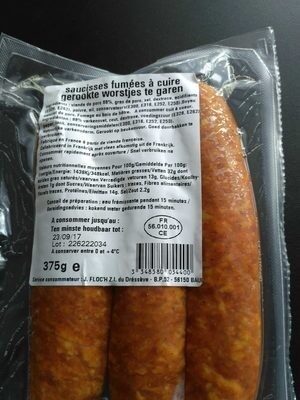Saucisses fumées à cuire - Jean Floc'h - 375 g
This product page is not complete. You can help to complete it by editing it and adding more data from the photos we have, or by taking more photos using the app for Android or iPhone/iPad. Thank you!
×
Barcode: 3348580054400 (EAN / EAN-13)
Common name: Saucisses fumées à cuire
Quantity: 375 g
Packaging: Plastic, Vacuum-packed
Brands: Jean Floc'h
Categories: Meats and their products, Meats, Prepared meats, Sausages, Smoked sausages
Labels, certifications, awards: French meat, Made in France, Smoked with beech wood
Origin of the product and/or its ingredients: France
Origin of ingredients: France
Manufacturing or processing places: Baud, France
Traceability code: FR 56.010.001 CE - Baud (Morbihan, France)
Countries where sold: France
Matching with your preferences
Environment
Packaging
Transportation
Report a problem
Data sources
Product added on by openfoodfacts-contributors
Last edit of product page on by off.
Product page also edited by kiliweb, roboto-app, yuka.ZXFFcUhZOWJ1ZDhub2NZZXJpdnEvTjlUbUtDN2VXM3ZLY0FESWc9PQ, yuka.sY2b0xO6T85zoF3NwEKvllV-CoPimhf_GCfkl0nVwuu3A8bsefNby6LAHas.










